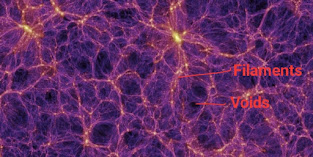THIS COULD ACTUALLY JEOPARDIZE OUR UNDERSTANDING ON THE EXPANSION OF OUR UNIVERSE
Some of the latest study shows that our solar system might be inside of one of the biggest Voids ever discovered. So, what are these Voids, how does it affect our beloved earth and how it could jeopardize our understanding on the expansion rate of our Universe? To know further, let's dig down a bit about space.
The Universe seems chaotic but it's not actually as bad as it seems. There is quite a bit of order, about 20% of our universe is made of Filaments and other 80% are of Voids, Voids are basically the empty space that are found in our Universe. Superclusters, Planets, Galaxies, Stars, Galactic Dusts are either densely packed into Filaments or in lonely Voids. Some of the latest study shows our milky way galaxy might exist in the middle of one of the largest Voids ever discovered. We could be living in the middle of nowhere, which is very unusual for a galaxy. As scary as it may sound researchers seems to think that it's not that big of a deal, it sounds that as we are further away from the Filaments our night skies are a bit darker but other than that now much else is different but there is something big that could come from this study though, if it's proven. Our universe is massive and it's constantly expanding just as the observable cosmos reaches about 46 Billion light years. Our astronomers have been struggling through decades to figure out the exact rate of universe's expansion also known as Hubble Constant (Ho). There are actually two methods to measure this is to look into the nearby bright stars that are moving further away from us or to look at the Cosmic Microwave Background Radiation left over from the BIG BANG and to see how fast that is moving. It's actually a big debate because these two methods do not gives us the same Constant. Researchers are more leaned towards the reading of the movements of nearby bright stars to measure the rate of expansion of our Universe. This new research suggests that as we are living in a Void, gravity is pulling us closer to the Filaments and that movements could be messing up calculations with the nearby stars. So to put it all together, if we are living inside of a Void, the CMB ( Cosmic Microwave Background Radiation) method of analyzing the expansion rate of our universe is probably more accurate. As gravity of the Filaments are pulling the Void closer, these movement could jeopardize the most common method to measure the expansion rate of Universe. Researchers are now looking into tons of experiments to figure out whether our milky way galaxy is actually in the middle of the largest Void ever discovered.

Comments
Post a Comment